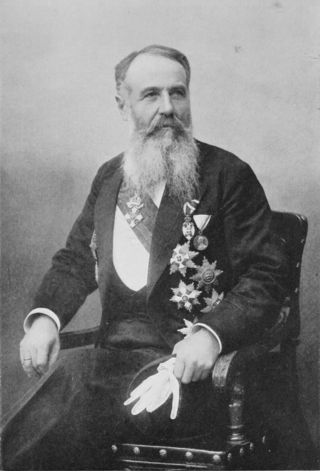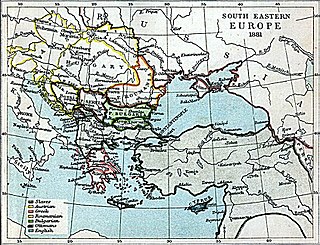
Austria-Hungary, also referred to as the Austro-Hungarian Empire, the Dual Monarchy or the Habsburg Monarchy, was a multi-national constitutional monarchy in Central Europe between 1867 and 1918. A military and diplomatic alliance, it consisted of two sovereign states with a single monarch who was titled both Emperor of Austria and King of Hungary. Austria-Hungary constituted the last phase in the constitutional evolution of the Habsburg monarchy: it was formed with the Austro-Hungarian Compromise of 1867 in the aftermath of the Austro-Prussian War, following wars of independence by Hungary in opposition to Habsburg rule. It was dissolved shortly after Hungary terminated the union with Austria in 1918.

The Balkan Wars were a series of two conflicts that took place in the Balkan states in 1912 and 1913. In the First Balkan War, the four Balkan states of Greece, Serbia, Montenegro and Bulgaria declared war upon the Ottoman Empire and defeated it, in the process stripping the Ottomans of their European provinces, leaving only Eastern Thrace under Ottoman control. In the Second Balkan War, Bulgaria fought against the other four original combatants of the first war. It also faced an attack from Romania from the north. The Ottoman Empire lost the bulk of its territory in Europe. Although not involved as a combatant, Austria-Hungary became relatively weaker as a much enlarged Serbia pushed for union of the South Slavic peoples. The war set the stage for the July crisis of 1914 and thus served as a prelude to the First World War.

The Central Powers, also known as the Central Empires, were one of the two main coalitions that fought in World War I (1914–1918). It consisted of the German Empire, Austria-Hungary, the Ottoman Empire, and Bulgaria; this was also known as the Quadruple Alliance.

The League of the Balkans was a quadruple alliance formed by a series of bilateral treaties concluded in 1912 between the Eastern Orthodox kingdoms of Greece, Bulgaria, Serbia and Montenegro, and directed against the Ottoman Empire, which still controlled much of Southeastern Europe.

Peter I was King of Serbia from 15 June 1903 to 1 December 1918. On 1 December 1918, he became King of the Serbs, Croats and Slovenes, and he held that title until his death three years later. Since he was the king of Serbia during a period of great Serbian military success, he was remembered by Serbians as King Peter the Liberator and also as the Old King.

Nikola Pašić was a Serbian and Yugoslav politician and diplomat. During his political career, which spanned almost five decades, he served five times as prime minister of Serbia and three times as prime minister of Yugoslavia, leading 22 governments in total. He played an instrumental role in the founding of Yugoslavia and is considered one of the most influential figures in Serbian twentieth-century history. With 12 years in office, Pašić was the longest-serving prime minister of Serbia.

The Bosnian Crisis, also known as the Annexation Crisis or the First Balkan Crisis, erupted on 5 October 1908 when Austria-Hungary announced the annexation of Bosnia and Herzegovina, territories formerly within the sovereignty of the Ottoman Empire but under Austro-Hungarian administration since 1878.

The Balkans theatre or Balkan campaign was a theatre of World War I fought between the Central Powers and the Allies.

The Serbian campaign was a series of military expeditions launched in 1914 and 1915 by the Central Powers against the Kingdom of Serbia during the First World War.

The Kosovo offensive of 1915 was a World War I offensive launched as part of the Serbian campaign of 1915. It involved the Central Powers and the Kingdom of Serbia.

The U-1 class was a class of two submarines or U-boats built for and operated by the Austro-Hungarian Navy. The class comprised U-1 and U-2. The boats were built to an American design at the Pola Navy Yard after domestic design proposals failed to impress the Navy. Constructed between 1907 and 1909, the class was a part of the Austro-Hungarian Navy's efforts to competitively evaluate three foreign submarine designs.
The Croat-Serb Coalition was a major political alliance in Austria-Hungary during early 20th century that governed the Croatian lands, the crownlands of Croatia-Slavonia and Dalmatia. It represented the political idea of a cooperation of Croats and Serbs in Austria-Hungary for mutual benefit. Its main leaders were, at first Frano Supilo and Svetozar Pribićević, then Pribićević alone.

In World War I, Albania had been an independent state, having gained independence from the Ottoman Empire on 28 November 1912, during the First Balkan War. It was recognised by the Great Powers as the Principality of Albania, after the Ottoman Empire officially renounced all its rights in May 1913. Being a fledgling new country, it quickly unravelled and just a few months after taking power, its German ruler, Prince Wilhelm, was forced to flee. After World War I broke out, anarchy took hold of the country as tribes and regions rebelled against central rule. To protect the Greek minority, Greek control was established in the southern districts replacing the Northern Epirote units beginning in October 1914. In response to this, Italy, although officially neutral at the time, also sent troops into the port of Vlorë, while Serbia and Montenegro took control of northern regions. In 1915 Serbia was overrun by combined German, Austro-Hungarian, and Bulgarian forces; the Serbian army retreated across the mountain passes of northern Albania, towards the Adriatic. Italian troops drove the Greeks from southern Albania and brought almost all Albanian territory under their control. Austrian forces invaded in June 1916; Austro-Hungarian forces remained in Albania until the end of the war when a multinational Allied force broke through and pushed them out in 1918.

The Austro-Hungarian Armed Forces occupied Serbia from late 1915 until the end of World War I. Austria-Hungary's declaration of war against Serbia on 28 July 1914 marked the beginning of the war. After three unsuccessful Austro-Hungarian offensives between August and December 1914, a combined Austro-Hungarian and German offensive breached the Serbian front from the north and west in October 1915, while Bulgaria attacked from the east. By January 1916, all of Serbia had been occupied by the Central Powers.
The Toplica Uprising was a mass uprising by Serbian rebels against the Bulgarian occupation forces that took place in Bulgarian occupied Serbia during the First World War. The rebels were motivated by grievances against the Bulgarian authorities for ordering conscription of local Serbs in the Bulgarian army, forced labour and the denationalization policy imposed on the indigenous population. The revolt was supported by Serbian guerrilla fighters known as Chetniks.

The Yugoslav monitor Sava is a Temes-class river monitor that was built for the Austro-Hungarian Navy as SMS Bodrog. She fired the first shots of World War I just after 01:00 on 29 July 1914, when she and two other monitors shelled Serbian defences near Belgrade. She was part of the Danube Flotilla, and fought the Serbian and Romanian armies from Belgrade to the mouth of the Danube. In the closing stages of the war, she was the last monitor to withdraw towards Budapest, but was captured by the Serbs when she grounded on a sandbank downstream from Belgrade. After the war, she was transferred to the newly created Kingdom of Serbs, Croats and Slovenes, and renamed Sava. She remained in service throughout the interwar period, although budget restrictions meant she was not always in full commission.

The convention of Sofia between Bulgaria and the Ottoman Empire (Turkey) was signed on 6 September (24 August O.S.) 1915. It rectified the border between the two countries in Bulgaria's favour in order to bring Bulgaria into the First World War on the side of the Central Powers.

The Austro-Serbian Convention of 1881 was a secret bilateral treaty that was signed in Belgrade on 28 June 1881 by Gabriel Freiherr Herbert-Rathkeal on behalf of Austria-Hungary and by Čedomilj Mijatović on behalf of the Principality of Serbia. The convention effectively turned Serbia into a protectorate state of Austria-Hungary, which meant its accession by proxy to the subsequent Triple Alliance (1882). Serbia then received Austrian support during the Serbo-Bulgarian War.

The Bulgarian occupation of Serbia during World War I started in Autumn 1915 following the invasion of Serbia by the combined armies of Germany, Austria-Hungary and Bulgaria. After Serbia's defeat and the retreat of its forces across Albania, the country was divided into Bulgarian and Austro-Hungarian occupation zones.

The Military General Governorate of Serbia was a military administration established by the Austro-Hungarian Army during the Austro-Hungarian occupation of Serbia. The Governorate existed from 1 January 1916 to 1 November 1918 during World War I. Along with Bulgarian occupied Serbia, it was one of the two separate occupation zones created after the Kingdom of Serbia was invaded and partitioned by the Central Powers.

















